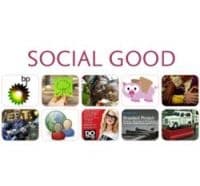 Recently, JWT published its “Social Good” report highlighting four macro trends that are shaping the way consumers, business and government are approaching social good strategies. What I like about this report is that it not only shares the trends, but the rationale/driving forces behind them and several examples along the way so you can truly see how it’s shaping consumer decisions and business practices. Here is a quick overview of the findings:
Recently, JWT published its “Social Good” report highlighting four macro trends that are shaping the way consumers, business and government are approaching social good strategies. What I like about this report is that it not only shares the trends, but the rationale/driving forces behind them and several examples along the way so you can truly see how it’s shaping consumer decisions and business practices. Here is a quick overview of the findings:
- The End of Goodwashing – The report highlights consumers’ increased expectations from nonprofits and brands and point out that consumers want more focus on real change and less “goodwashing”. Some interesting highlights from this section include:
- Rating products – The report lists several examples of websites designed to rate products on their social good index, such as GoodGuide and shares examples of corporations developing sustainability indexes for themselves and/or the products to sell, including Apple, IKEA, Walmart and others.
- Benefit Corporations – News to me, this is a new kind of company that operates under new legal provisions that make it easier to put sustainability and accountability at the center of the business model. Organizations must be certified by B Lab, a nonprofit organization that certifies companies that are, in fact, integrating “doing good” strategies into their business model.

- The Rise of Shared Value – No surprise, as consumer expectations change and businesses begin to see the value in generating “real change”, corporations are shifting their models by integrating social issues into core business strategies. This movement reflects the understanding that generating a profit and achieving social progress are not mutually exclusive. Businesses can become a force for positive change while enhancing long-term competitiveness. A few items of interest here include:
- Emerging Markets – Efforts within emerging markets are booming as corporations look to expand market share. Yet a shift in focus is occurring as organizations realize that if they help to address some of the underlying local business issues they can generate “real change”, thereby helping local markets to thrive and grow their own bottom line.
- Partnerships – The blurring of lines between corporations, nonprofits and governments continues to show that all entities are becoming more creative in establishing partnerships and a fundamental understanding that we can’t solve the big issues of today working in silos.
- Creative Urban Renewal – As the global population migrates to more urban centers, cities offer brands opportunities to get involved in urban renewal – improving local environments, adding beauty or helping to bring communities together. Some of the drivers affecting this trend include:
- Government Stagnation/Lack of Funding -There is a lack of infrastructure funding to support the growing needs of urban centers. The data indicates that many citizens don’t feel government is doing enough to improve the community. This gives the private sector an opportunity to engage in needed improvements and accelerate projects that add community-based value.
- Brand Involvement Is Expected – Supporting the above thinking, consumers are starting to hold organizations to a higher standard, indicating brands and large corporations have a responsibility to improve local communities.
- Ripping a Page from the For-Profit Playbook – A trend long in-play, this report indicates that nonprofits continue to focus on adopting for-profit business methods, placing more emphasis on cause and effect between donor dollars and measurable results. A few of the drivers mentioned in this section include:
- A Race for Funding – As more organizations compete for less funding, nonprofits must show donors that their organization is, without a doubt and better than the other guy, making a difference.
- Desire for Self-Sufficiency – Because most of all funds raised by nonprofits carry stipulations on how those funds can be used, many organizations are now looking to create financial autonomy through social enterprise ventures.

The report also includes in-depth information on the Millennial generation and its influence on social good and brand involvement, as well as several in-depth case studies. Simply put: the report is chock-full of great information for anyone seeking to understand more about the future direction of partner alliances, cause marketing, corporate social responsibility, social enterprise and many, many other “social good” concepts that remain intertwined as we all seek ways to do well by doing good.
